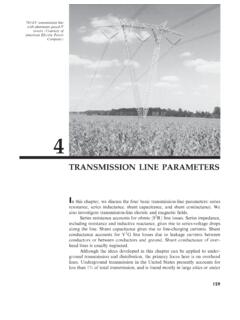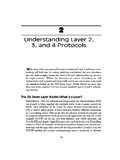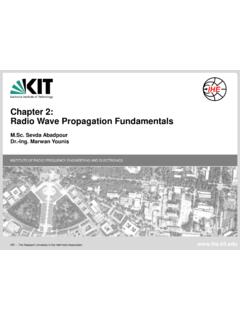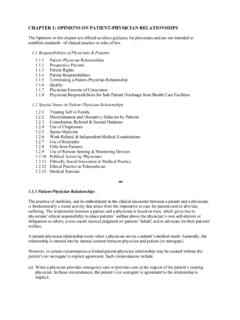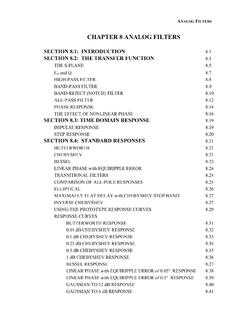Transcription of Chapter 11 Helicopter Emergencies and Hazards
1 11-1 IntroductionToday, helicopters are quite reliable. However, Emergencies do occur, whether a result of mechanical failure or pilot error, and should be anticipated. Regardless of the cause, the recovery needs to be quick and precise. By having a thorough knowledge of the Helicopter and its systems, a pilot is able to handle the situation more readily. Helicopter Emergencies and the proper recovery procedures should be discussed and, when possible, practiced in flight. In addition, by knowing the conditions that can lead to an emergency, many potential accidents can be avoided. Helicopter Emergencies and HazardsChapter 1111-2 Normal Powered FlightAutorotationDirection of flightDirection of flightFigure 11-1. During an autorotation, the upward flow of relative wind permits the main rotor blades to rotate at their normal speed. In effect, the blades are gliding in their rotational plane. Several factors affect the rate of descent in autorotation: bank angle, density altitude, gross weight, rotor rpm, trim condition, and airspeed.
2 The primary ways to control the rate of descent are with airspeed and rotor rpm. Higher or lower airspeed is obtained with the cyclic pitch control just as in normal powered flight. In theory, a pilot has a choice in the angle of descent, varying, from straight vertical to maximum horizontal range (which is the minimum angle of descent). Rate of descent is high at zero airspeed and decreases to a minimum at approximately 50 60 knots, depending upon the particular Helicopter and the factors just mentioned. As the airspeed increases beyond that which gives minimum rate of descent, the rate of descent increases landing from an autorotation, the only energy available to arrest the descent rate and ensure a soft landing is the kinetic energy stored in the rotor blades. Tip weights can greatly increase this stored energy. A greater amount of rotor energy is required to stop a Helicopter with a high rate of descent than is required to stop a Helicopter that is descending more slowly.
3 Therefore, autorotative descents at very low or very high airspeeds are more critical than those performed at the minimum rate of descent airspeed. Refer to the height/velocity diagram discussion in Chapter 7, Helicopter type of Helicopter has a specific airspeed and rotor rpm at which a power-off glide is most efficient. The specific airspeed is somewhat different for each type of Helicopter , but certain factors affect all configurations in the same manner. In general, rotor rpm maintained in the low green area (see Figure 5-3) gives more distance in an autorotation. Heavier Helicopter weights may require more collective to control rotor rpm. Some helicopters need slight adjustments to minimum rotor rpm settings for winter versus summer AutorotationIn a Helicopter , an autorotative descent is a power-off maneuver in which the engine is disengaged from the main rotor disk and the rotor blades are driven solely by the upward flow of air through the rotor.
4 [Figure 11-1] In other words, the engine is no longer supplying power to the main rotor. The most common reason for an autorotation is failure of the engine or drive line, but autorotation may also be performed in the event of a complete tail rotor failure, since there is virtually no torque produced in an autorotation. In both cases, maintenance has often been a contributing factor to the failure. Engine failures are also caused by fuel contamination or exhaustion as well resulting in a forced the engine fails, the freewheeling unit automatically disengages the engine from the main rotor, allowing it to rotate freely. Essentially, the freewheeling unit disengages anytime the engine revolutions per minute (rpm) is less than the rotor the instant of engine failure, the main rotor blades are producing lift and thrust from their angle of attack (AOA) and velocity. By lowering the collective (which must be done immediately in case of an engine failure), lift and drag are reduced, and the Helicopter begins an immediate descent, thus producing an upward flow of air through the rotor disk.
5 This upward flow of air through the rotor disk provides sufficient thrust to maintain rotor rpm throughout the descent. Since the tail rotor is driven by the main rotor transmission during autorotation, heading control is maintained with the antitorque pedals as in normal , and high altitude versus sea level flights. For specific autorotation airspeed and rotor rpm combinations for a particular Helicopter , refer to the Rotorcraft Flight Manual (RFM). The specific airspeed and rotor rpm for autorotation is established for each type of Helicopter based on average weather, calm wind conditions, and normal loading. When the Helicopter is operated with heavy loads in high density altitude or gusty wind conditions, best performance is achieved from a slightly increased airspeed in the descent. For autorotation at low density altitude and light loading, best performance is achieved from a slight decrease in normal airspeed. Following this general procedure of fitting airspeed and rotor rpm to existing conditions, a pilot can achieve approximately the same glide angle in any set of circumstances, and thereby estimate the touchdown point is important that pilots experience autorotations from various airspeeds.
6 This provides better understanding of the necessary flight control inputs to achieve the desired airspeed, rotor rpm and autorotation performance, such as the maximum glide or minimum descent airspeed. The decision to use the appropriate airspeed and rotor rpm for the given conditions should be instinctive to reach a suitable landing area. The Helicopter glide ratio is much less than that of a fixed-wing aircraft and takes some getting used to. The flare to land at 80 knots indicated airspeed (KIAS) will be significantly greater than that from 55 KIAS. Rotor rpm control is critical at these points to ensure adequate rotor energy for cushioning the collective pitch control to manage rotor rpm. If rotor rpm builds too high during an autorotation, raise the collective sufficiently to decrease rpm back to the normal operating range, then reduce the collective to maintain proper rotor rpm. If the collective increase is held too long, the rotor rpm may decay rapidly.
7 The pilot would have to lower the collective in order to regain rotor rpm. If the rpm begins decreasing, the pilot must again lower the collective. Always keep the rotor rpm within the established recommended range for the Helicopter being ControlRotor rpm in low inertia rotor systems has been studied in simulator flight evaluations which indicate that the simultaneous application of aft cyclic, down collective, and alignment with the relative wind (trim) at a wide range of airspeeds, including cruise airspeeds, is critical for all operations during the entry of an autorotation. The applicable Rotorcraft Flight Manual (RFM) should be consulted to determine the appropriate procedure(s) for safely entering an autorotation. This is vitally important since the procedure(s) for safely entering an autorotation may vary with specific makes and/or models of helicopters. A basic discussion of the aerodynamics and control inputs for single rotor systems is in order pilots must understand the use of the collective for rotor rpm control during power off autorotations in a turn.
8 Upward movement of the collective reduces the rpm and downward movement increases the rpm. Cyclic movement is primarily associated with attitude/airspeed control in powered flight but may not be given the credit appropriate for rotor rpm control during practice and emergency power off autorotations. As long as the line of cyclic movement is parallel with the flight path of the Helicopter (trimmed), the aft movement of the cyclic also creates greater air flow up through the bottom of the rotor disk and contributes to an increase in rotor rpm. If the flight path is 10 degrees to the right of the longitudinal axis of the Helicopter , theoretically, the cyclic should be moved 10 degrees aft and left of the longitudinal axis to get maximum air up through the rotor the pilot lowers the collective in reaction to a loss of power during cruise flight there may be a tendency for the nose of the Helicopter to pitch down. As a result, the pilot may tend to lean forward slightly, which delays the application of simultaneous aft cyclic to prevent the pitch change and associated loss of rotor rpm.
9 A slight gain in altitude at cruise airspeed during the power off entry into an autorotation should not be of great concern as is the case for the execution of practice or actual quick accident investigations have concluded that, when faced with a real power failure at cruise airspeed, pilots are not simultaneously applying down collective, aft cyclic, and antitorque pedal inputs in a timely manner. Low inertia rotor systems store less kinetic energy during autorotation and, as a result, rotor rpm decays rapidly during deceleration and touchdown. Conversely, less energy is required to regain safe rotor rpm during autorotation entry and autorotative descent. The pilot should immediately apply simultaneous down collective, aft cyclic and trim the Helicopter for entry into an autorotation initiated at cruise airspeed. If rotor rpm has been allowed to decrease, or has inadvertently decreased below acceptable limits, an application of aft cyclic may help rebuild rotor rpm.
10 This application of aft cyclic must be made at least at a moderate rate and may be combined with a turn, either left or right, to increase airflow through the rotor system. This will work to increase rotor rpm. Care should be maintained to not over-speed the rotor system as this is Management during Autorotation Training The following sections describe enhanced guidelines for autorotations during rotorcraft/ Helicopter flight training, as stated in Advisory Circular (AC) 61-140. There are 11-412345 Figure 11-2. Straight-in autorotation. risks inherent in performing autorotations in the training environment, and in particular the 180-degree autorotation. This section describes an acceptable means, but not the only means, of training applicants for a rotorcraft/ Helicopter airman certificate to meet the qualifications for various rotorcraft/ Helicopter ratings. You may use alternate methods for training if you establish that those methods meet the requirements of the Helicopter Flying Handbook (HFH), FAA practical test standards (PTS), and the Rotorcraft Flight Manual (RFM).











